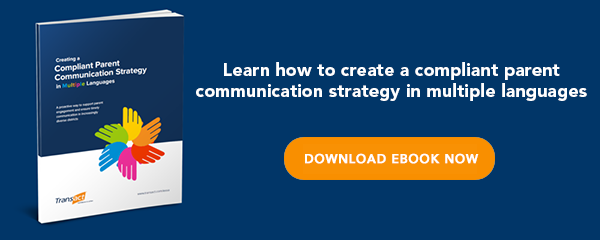Effective school-to-home communication plays a vital role when it comes to achieving successful student outcomes. However, staying in compliance with Every Student Succeeds Act (ESSA) requirements when communicating with parents and family members can prove quite challenging for schools and districts, especially with the increases to Parent and Family Engagement requirements under ESSA.
To comply with ESSA Parent and Family Engagement requirements, school districts need the right funding and technology in place to support their parent and family engagement initiatives. Here’s an overview of funding options for solutions to ESSA school-to-home communication requirements.
ESSA School-to-Home Communication Requirements
ESSA requires school-to-home communications take place "to the extent practicable, in a language that parents can understand.” In other words, regular two-way communications with parents must be available in the parent's preferred language.
Title I-funded schools and school districts must develop a parent and family engagement policy in consultation with all relevant stakeholders, including parents. These parent and family engagement policies function more like plans because they do not need an official school board vote to implement. The district-level policy covers all schools in the district, even if a school does not receive Title I funding. After implementing a parent and family engagement policy, schools and districts must conduct annual evaluations of the content and effectiveness of their policy. ESSA also stipulates that they must provide school and district report cards in a language that parents and families can understand.
Funding Options for Meeting ESSA Requirements
ESSA authorizes federal funding to aid states and school districts in providing all students with access to a well-rounded education. ESSA funds are the main source of meeting federally-mandated communication requirements. States and school districts typically avoid meeting ESSA requirements using state and local funding. Funding options for solutions to meet ESSA school-to-home communication requirements include the following:
Title I Funding
Schools that operate a schoolwide Title I program must develop and annually review a schoolwide plan in consultation with parents and family members. ESSA additionally requires that parents and families receive schoolwide plans in a language they understand. Districts that receive at least $500K must reserve 1% of their Title I funds for parent and family engagement activities that align with the district's parent and family engagement policy.
Title III Funding
Districts must use funds to implement effective activities and strategies that enhance or supplement language instruction programs for English Learners (EL). The law specifies that these programs should include parent, family, and community engagement activities. Funding can also go toward early college or dual enrollment programs or courses to help ELs achieve success. Additionally, Title III-funded early childhood activities or programs are an optional expenditure that must include an assurance that the district will coordinate activities and share relevant data with other early childhood education providers.
Title IV Funding
The U.S. Department of Education awards funding to applicants who wish to establish Statewide Family Engagement Centers. Title IV funding does not go through state hands but is provided directly to grantees. Fund recipients should use these grants to help parents actively participate in their student’s education and to develop and implement statewide parent and family engagement initiatives.
How Technology Helps Districts Meet ESSA Communication Requirements
Meeting ESSA communication requirements can prove challenging for schools and their greater districts, especially with complex reporting mandates. Fortunately, technology exists to help districts comply with ESSA school-to-home communication requirements.
An education compliance solution like TransACT ParentNotices helps to standardize, distribute, organize, and track school-to-home communications in all high-priority languages, minimizing compliance risks and eliminating the need for costly translation services. ParentNotices offers a number of beneficial features that help school districts meet parent and family engagement communication requirements, from notices written by federal programs experts, legal review by education law experts, and translations completed by qualified, trained translators. Additional features of ParentNotices include:
- Hosting existing forms in one centralized and standardized platform for all staff
- Building new digital forms and automating approvals with workflows
- Collecting digital signatures from parents and families on any device
- Integrating with student roster data to auto-fill forms and notices
- Delivering notices to parents in their preferred language on tablets, computers, and mobile device
Using technology to meet ESSA communication requirements allows teachers and staff to access translations, compliance guidance, and pre-written forms in multiple languages at the moment they need them, from any device. To see TransACT ParentNotices in action, schedule a quick demo.





